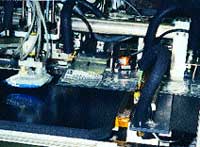Glue sticks are in the bag

FPC Corp., Wauconda, IL, started in 1968 as a manufacturer of pop rivets and eyelets and began manufacturing hot-melt glue, glue sticks and glue guns in 1983. It introduced the concept of selling these products to the floral and craft trade. The company produces 1/4-in.- and 1/2-in.-dia glue sticks in 4- and 10-in. lengths. All four of these products are packed in different quantities, including 6-, 12-, 20-, 50- and 100-count bags.
FPC had always packed glue sticks into bags by hand, but in 1997 they hired a company to build a piece of equipment to count the sticks and load them into bags. The resulting bag machine worked well, but the infeed system was unsatisfactory. President Pat Kamins hired someone else to build a machine to count the number of sticks going to the bagger, but that company went out of business. "I had seen APAI at a trade show, so I decided to ask them to take over the project.
|
Film passes over dancer rolls, goes up and over a guide roll, and then comes back down over a plow. |
|
A longitudinal seal-bar seals the bottoms of the bags. |
They came up with a complete new design for the counter, which they installed on their regular Flat-Pak horizontal form/fill/seal machine," he says.
"We sent product to the APAI factory in Roosevelt, NJ, in early 2000. After a couple of months in which they got the bugs out, we installed the machine in our factory that May, and the machine was successful from the beginning. APAI is a very easy company to work with, and I was very impressed with John Wojnicki, their sales manager. He is the type of person from whom you want to buy equipment."
Microprocessor-controlled machine is easy to operate
FPC?s APAI Flat-Pak intermittent-motion machine runs preprinted polyethylene film with a product description on the front and use-instructions in three languages (English, Spanish and French) on the back. The roll of film is mounted beside the machine, and the film passes over dancer rolls, goes up and over a guide roll, and then comes back down over a plow that folds it to form a center fold.
|
An arm with four suction cups rotates over, picks up the sealed bag, and drops it into a box located beside the machine. |
|
A counter delivers the proper number of glue sticks from the feed hopper, below, onto a shuttle conveyor that delivers them to the bag-loading chute. |
The film leaving the plow makes a right angle turn and enters the accessories portion of the machine where the header seal and hole punches are added before it is cut into a bag. Next, a sealer bar, mounted perpendicular to the film flow, seals and cuts the bag about one inch from the folded edge. The bag continues on the carrier to the loading station, where it is clamped into position so that the infeed chute can be indexed forward into the bag, and the glue sticks pushed into the bag.
At present, the glue sticks are loaded manually into a feed hopper on the back of the machine, although the plant is looking into an automatic loading system. A counter delivers the proper number of glue sticks onto a shuttle conveyor that delivers them to the bag-loading chute. As the bag stops, the chute indexes forward, opening the bag, and an arm pushes the counted sticks into the bag. At the end of the fill cycle, grippers grasp the edges of the bag and pull it taut to create a very tight package for sealing. "We absolutely required a tight bag, and this horizontal machine is the only one I know of that can achieve it. We looked into vertical machines, but they all provide a very loose pack," says Kamins.
The bags then travel past another longitudinal seal-bar that seals the bottom, after which an arm with four suction cups rotates over, picks up the bag, and drops it into a box located beside the machine.
FPC runs different-sized bags containing from 20 to 100 glue sticks. Operating requirements for each of these bags is entered into the menu of the microprocessor-controlled Flat-Pak machine, and the system automatically sets machine parameters and count rates when the operator selects the particular product from the menu in the control panel. The control system counts the sticks as they are delivered to the shuttle conveyor and shuts down the machine if the correct number is not delivered.
To maintain perfect film registration, sensors detect eyemarks on the film as it enters the machine and make minute adjustments to the film movement.
"This machine is phenomenal, and we will certainly go back to APAI when we are ready for additional equipment," says Kamins.
More information is available:
Form/fill/seal machine: APAI, 609/448-9210. Circle No. 216.
About the Author(s)
You May Also Like






